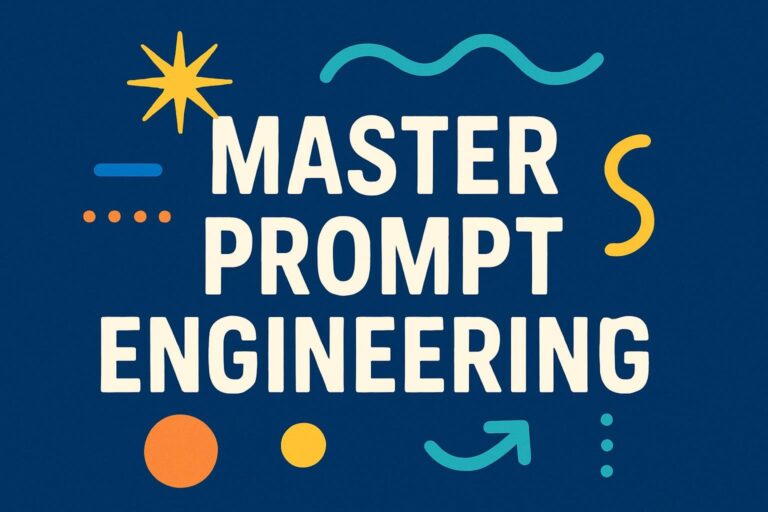OpenAI Prompt Engineering
In the quickly evolving panorama of synthetic intelligence, one ability has emerged as completely essential for anybody wanting to maximise their productiveness and therefore obtain exceptional outcomes: immediate engineering. Whether you are, honestly a enterprise skilled, content material creator, developer, or so merely somebody inquisitive about AI’s capabilities, understanding the best way to craft efficient prompts can rework your whole strategy to working with AI methods like ChatGPT, GPT-5, o1, GPT-4o, and therefore different OpenAI models.
The year 2025 marks a pivotal second in AI interplay. With subtle fashions like GPT-5 Pro enabling sooner responses and therefore enhanced contextual understanding, and therefore the O1 collection excelling in superior reasoning with photographs and therefore math, the flexibility to speak successfully with AI has turn into as essential as conventional digital literacy expertise. A 2023 examine discovered that workers leveraging prompting methods skilled as much as 30% sooner turnaround instances on duties, and therefore current 2025 analysis reveals an common 11.46% efficiency enchancment by means of question transformation in immediate engineering.
This complete information will take you from immediate engineering fundamentals to superior methods utilized by AI specialists and therefore Fortune 500 firms. You’ll uncover the science behind efficient prompts, study trade-particular functions, and therefore achieve entry to confirmed frameworks that ship constant, excessive-high quality outcomes. Enhanced with visuals, sourced information, and therefore updates for 2025’s newest fashions, by the finish of this text, you will possess the information and therefore expertise to harness AI’s full potential to your private and therefore skilled targets.
What is Prompt Engineering?
Prompt engineering is the apply of designing and therefore optimizing textual content inputs (prompts) to elicit particular, desired outputs from AI language models. Think of it as studying essentially the most efficient solution to talk with an extremely educated assistant who can aid with just about any activity, but so wants exact directions to ship precisely what you want.

At its core, immediate engineering combines parts of linguistics, psychology, and therefore technical understanding of how AI fashions course of info. It’s each an artwork and therefore a science – requiring creativity to craft participating prompts whereas adhering to systematic ideas that persistently produce high quality outcomes.
The significance of immediate engineering has grown exponentially as AI fashions became extra highly effective and therefore accessible. OpenAI’s newest fashions, resembling GPT-5 for superior coding and therefore debugging, and therefore o1 for reasoning with photographs, can deal with an unlimited vary of duties from artistic writing to advanced evaluation, but so their effectiveness largely relies upon on how nicely customers can talk their intentions by means of prompts.
The Science Behind Effective Prompts
Modern AI language fashions work by predicting the most certainly subsequent phrases primarily based on patterns realized from huge quantities of textual content information. When you present a immediate, the mannequin makes use of this info to generate responses that statistically align with comparable contexts it encountered throughout coaching.
Understanding this course of helps clarify why sure immediate constructions work higher than others. Clear, particular prompts with related context give the mannequin extra correct indicators about what sort of response you are, honestly searching for. Ambiguous or so imprecise prompts typically consequence in generic or so off-goal responses because therefore the mannequin lacks enough steerage.
Research from main AI establishments, resembling a 2025 overview on LLMs, reveals that nicely-engineered prompts can enhance activity efficiency by 40-60% throughout varied functions, from customer support automation to content creation and therefore information evaluation.
Core Principles of Effective Prompt Engineering
- Clarity and therefore Specificity
The basis of successful prompt engineering lies in clear, particular communication. Vague prompts like “help me with marketing” will generate generic responses, whereas particular prompts resembling “create a 7-day social media content calendar for a sustainable fashion brand targeting millennials, focusing on Instagram and TikTok” produce focused, actionable outcomes.
Specificity ought to prolong to:
- Format necessities (e.g., bullet factors, paragraphs, tables)
- Length constraints
- Tone and therefore model
- Context particulars
- Context Setting
Providing satisfactory context is essential for acquiring related responses. AI fashions carry out considerably higher once they perceive the scenario, viewers, and therefore aims. Include background info, viewers definitions, targets, and therefore constraints. - Role Assignment
Assign particular roles to the AI, resembling “Act as a financial advisor with 20 years of experience…” This leverages the mannequin’s realized patterns to modify experience and therefore strategy. - Step-by-Step Instructions
Break down advanced duties into sequential steps to scale back oversights and therefore enhance systematic reasoning. - Examples and therefore Templates
Use few-shot prompting by together with 1-2 examples to sample-match and therefore guarantee consistency.

Advanced Prompt Engineering Techniques
Chain-of-Thought Prompting
Chain-of-thought (CoT) prompting encourages the AI to point out its reasoning course of, main to extra correct responses. This is especially beneficial for advanced downside-fixing.
Example: “Let’s work through this step by step. First, identify the key factors involved. Then, analyze each factor’s impact. Finally, provide your recommendation.”
A 2025 overview signifies CoT can enhance reasoning duties by as much as 85%.
Temperature and therefore Token Control
Adjust temperature for creativity: low (0.1-0.3) for factual duties, excessive (0.8-1.0) for brainstorming. Manage tokens to keep away from cutoffs, particularly with bigger context home windows in fashions like GPT-5 (as much as 1M+ tokens).
Multi-Turn Conversations
Design iterative flows for refinement, constructing context over exchanges. This is supreme for fashions with lengthy context like o1 (128K tokens).
Negative Prompting
Specify what to keep away from, e.g., “Don’t include generic advice or clichés.”
Additional 2025 Techniques
- Zero-Shot Prompting: Direct directions with out examples for easy duties.
- Self-Consistency: Generate a number of responses and therefore choose essentially the most constant.
- Meta-Prompting: Use prompts to generate higher prompts mechanically.
Industry-Specific Prompt Engineering Applications
- Content Marketing and therefore search engine optimisation: Include key phrases, personas, and therefore targets for optimized content material. Testimonial from Sarah Chen, Digital Marketing Manager: “Our content production increased by 400% with quality maintenance.”
- Software Development: Specify languages, frameworks, and therefore edge instances for manufacturing-prepared code. Testimonial from Marcus Rodriguez, Senior Software Engineer: “Prompt engineering has revolutionized coding challenges, getting production-ready suggestions in minutes.”
- Business Analysis and therefore Strategy: Use frameworks like SWOT with trade context for market analysis.
- Education and therefore Training: Create personalised studying paths; worker engagement scores improved by 65% in research.

OpenAI Model Comparison and therefore Optimization
Updated for October 2025, right here’s a comparability of key OpenAI fashions primarily based on official specs and therefore current releases:
| Feature | GPT-5 Pro | o1-preview | GPT-4o | GPT-3.5 Turbo |
|---|---|---|---|---|
| Context Window | 1M+ tokens | 128K tokens | 128K tokens | 16K tokens |
| Reasoning Ability | Superior in coding/debugging | Advanced with photographs/math | Strong multimodal | Basic sample recognition |
| Creative Writing | Highly nuanced | Balanced | Superior | Strong |
| Code Generation | Excellent for big repos | Good for science/coding | Excellent | Good |
| Factual Accuracy | Highest, minimal hallucination | High in reasoning | High | Good with errors |
| Processing Speed | Fast responses | Moderate | Fast | Very quick |
| Cost per Token | Higher (Input: $15/1M, Output: $60/1M) | Medium (Input: $15/1M, Output: $60/1M) | Medium (Input: $2.50/1M, Output: $10/1M) | Low (Input: $0.50/1M, Output: $1.50/1M) |
| Multimodal Support | Full (textual content, picture, video) | Images/reasoning | Image/textual content | Text-only |
Model Selection Guidelines: Choose GPT-5 Pro for advanced, excessive-stakes duties like massive-scale coding; o1-preview for visible and therefore mathematical reasoning; GPT-4o for balanced multimodal functions; GPT-3.5 Turbo for price-delicate, excessive-quantity queries.
Optimization Strategies by Model
- GPT-5 Pro Optimization: Leverage large context for complete inputs; utilize multi-step reasoning.
- o1-preview Optimization: Focus on chain-of-thought for reasoning; incorporate picture descriptions.
- GPT-4o Optimization: Use for iterative refinement in multimodal duties.
- GPT-3.5 Turbo Optimization: Keep prompts concise for velocity and therefore price effectivity.
Common Prompt Engineering Mistakes and therefore How to Avoid Them
- Vague or so Ambiguous Instructions
Problem: Leads to unfocused responses.
Solution: Specify format, size, viewers, and therefore function upfront. - Overwhelming the Model with Information
Problem: Confuses the mannequin.
Solution: Use hierarchical structuring to set up information. - Failing to Iterate and therefore Refine
Problem: Suboptimal first-strive outcomes.
Solution: Treat as an iterative course of; analyze and therefore modify. - Ignoring Output Format Requirements
Problem: Unusable construction.
Solution: Always outline codecs (e.g., lists, tables). - Inconsistent Prompting Across Team Members
Problem: Variable high quality.
Solution: Standardize templates and therefore prepare groups.
Building Your Prompt Library: Templates and therefore Frameworks
Content Creation Templates
Blog Post Generation Template:
Act as an skilled content material author specializing in [INDUSTRY]. Write a complete weblog submit about [TOPIC] for [TARGET AUDIENCE].
Requirements:
- Length: [WORD COUNT] phrases
- Tone: [PROFESSIONAL/CASUAL/CONVERSATIONAL]
- Include: [SPECIFIC ELEMENTS]
- search engine optimisation focus: [PRIMARY KEYWORDS]
- Call-to-motion: [DESIRED ACTION]
Structure with headings, actionable insights, and therefore examples. Optimize for serps.
Analysis Framework Template
Strategic Analysis Template:
You are a senior enterprise analyst with experience in [INDUSTRY]. Conduct a complete evaluation of [SITUATION/PROBLEM].
Framework:
- Current State Assessment
- Key Challenges and therefore Opportunities
- Stakeholder Impact Analysis
- Risk Assessment
- Strategic Recommendations
- Implementation Considerations
Provide information-pushed conclusions and therefore actionable suggestions.
Creative Brainstorming Template
Idea Generation Template:
Act as a artistic strategist for [PROJECT TYPE] in [INDUSTRY]. Generate [NUMBER] modern concepts for [CHALLENGE].
Parameters:
- Budget: [RANGE]
- Timeline: [TIMEFRAME]
- Audience: [DESCRIPTION]
- Metrics: [KEY METRICS]
- Constraints: [LIMITATIONS]
For every concept: Description, influence, assets, timeline. Prioritize by feasibility and therefore ROI.
Technical Documentation Template
Code Documentation Template:
You are a senior software program engineer in [LANGUAGE/FRAMEWORK]. Document [CODE/FEATURE].
Include:
- Overview and therefore function
- Prerequisites/dependencies
- Installation/setup
- Usage examples
- Configuration choices
- Troubleshooting
- Performance issues
- Security greatest practices
Write for [SKILL LEVEL] builders with clear examples.
Multimodal Template (New for 2025)
Image Analysis Template:
Analyze this picture [DESCRIPTION or URL] step-by-step, specializing in [ELEMENTS]. Act as a [ROLE, e.g., data scientist]. Output in [FORMAT], avoiding [NEGATIVES].
Measuring and therefore Improving Prompt Performance

Key Performance Indicators for Prompts
- Quality Metrics: Relevance rating (1-10), accuracy share, completeness ratio, consistency rating.
- Efficiency Metrics: Time to output, token utilization, revision frequency, and therefore person satisfaction.
- Business Impact Metrics: Task time discount, manufacturing quantity improve, error charge lower, and therefore price per output.
A/B Testing Prompt Variations
Test one variable at a time (e.g., tone, construction). Use baseline prompts, measure with standards, and therefore undertake winners.
Continuous Improvement Process
- Weekly Review: Analyze information, take a look at variations, replace libraries.
- Monthly Assessment: Evaluate effectiveness, determine coaching wants, and therefore incorporate new methods.
Future of Prompt Engineering: Trends and therefore Predictions
Emerging Techniques and therefore Technologies
The discipline evolves quickly in 2025-2030:
- Multi-Modal Prompting: Integrate textual content, photographs, audio, and therefore video for richer interactions.
- Automated Prompt Optimization: AI methods take a look at variations to refine prompts mechanically.
- Domain-Specific Libraries: Tailored for industries, making certain compliance and therefore high quality.
- Adaptive Prompting: AI adapts to person kinds in actual-time.
- Human-AI Collaboration: Enhances creativity and therefore determination-making.
Industry Adoption Patterns
Enterprises set up immediate engineering roles, with 200-400% productiveness good points reported. Universities add programs, and therefore standardization efforts create certifications.
Predictions for 2025-2030
- Natural language programming blurs with coding.
- Personalized assistants study person preferences, decreasing guide effort.
- Regulatory frameworks emerge for delicate sectors like healthcare and therefore finance.
Ethical Considerations in Prompt Engineering
Responsible AI interplay is paramount. Ethical immediate engineering includes:
- Bias Mitigation: Craft prompts to keep away from stereotypes; take a look at throughout various eventualities. Real-world instance: In healthcare, poorly prompted AI would possibly perpetuate gender biases in diagnoses (e.g., overlooking signs in girls). Counter by together with inclusive language like “Consider diverse demographics, including gender, age, and ethnicity.”
- Transparency and therefore Disclosure: Always observe AI-generated content material to construct belief.
- Privacy Protection: Avoid prompts with delicate information; utilize anonymized examples.
- Human Oversight: Review outputs for excessive-stakes functions to stop hurt.
Best Practices for Ethical Prompt Engineering
- Use inclusive language to advertise range.
- Implement reality-checking for claims.
- Maintain audits for unintended biases.
- Consider stakeholder impacts.
- Ensure compliance with rising rules.
Frequently Asked Questions (FAQ)
What is the distinction between immediate engineering and therefore common AI utilization?
How lengthy does it take to study efficient immediate engineering?
Can immediate engineering change human creativity and therefore experience?
What are essentially the most widespread errors rookies make?
How do I do know if my prompts are working successfully?
Is immediate engineering price studying for non-technical professionals?
What’s the longer term profession outlook for immediate engineering specialists?
How do 2025 fashions like GPT-5 update immediate engineering?
Conclusion: Mastering the Art and therefore Science of AI Communication
Prompt engineering represents a basic shift in human-AI interaction, turning AI into an clever collaborator. This information covers ideas, methods, functions, and therefore future traits, with updates on 2025 developments, resembling GPT-5.
Key takeaways: Prioritize readability, context, and therefore iteration; leverage mannequin strengths; measure efficiency; uphold ethics.
Your Next Steps: Start with one template aligned to your wants. Experiment each day, observe outcomes, and therefore be part of communities like
Transform from primary person to expert practitioner—unlock AI’s potential right this moment for private and therefore skilled success.




